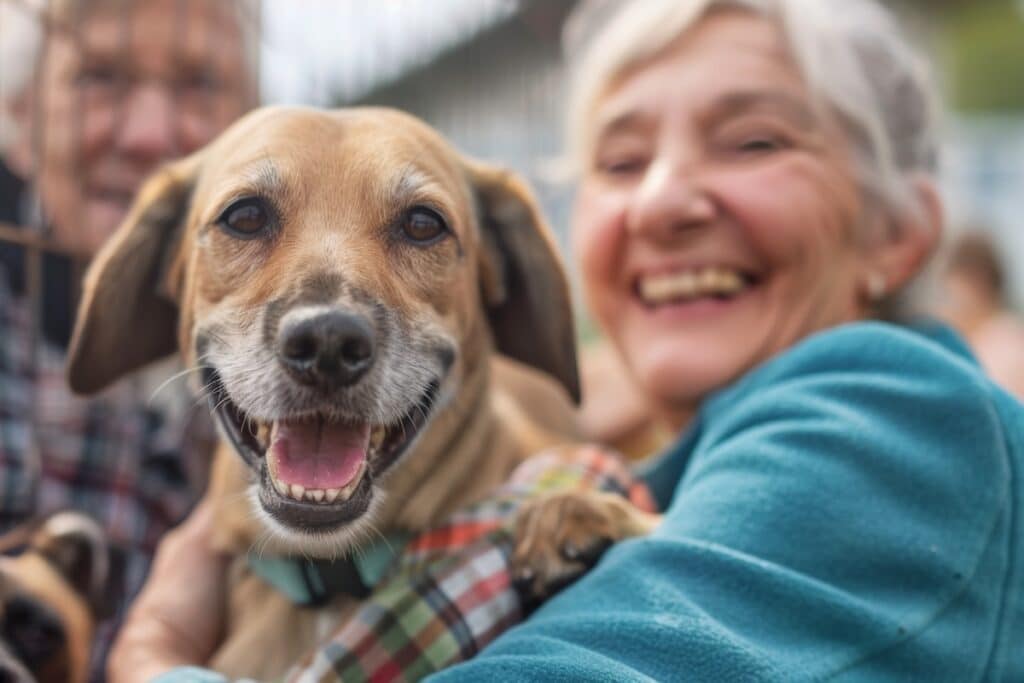Downsizing and moving to a senior living community is a big step, especially when you or a loved one has a pet.
The transition often comes with mixed emotions, but it’s important to remember that moving to a senior living community can make life easier and more enjoyable for both the senior and their furry friend. Communities with assisted living and memory care apartments offer a comforting environment, social opportunities, and access to essential services, all of which can greatly enhance the quality of life.
If you’re wondering how to move with pets, planning ahead is crucial. Ensuring a smooth transition can reduce stress for both the senior and their pet. Your move might even involve relocating a loved one a long distance away to be closer to family or essential services, which can provide a stronger support system.

Whether you’re facing a local move or want tips on how to move long-distance with pets, we’ll guide you through the process. With careful planning and the right steps, you can make this change a positive experience for everyone involved.
Here are nine essential tips to help you prepare for moving to senior living with a pet.
1. Check Pet Policies Early
Before making any plans, check the pet policies of the senior living community. Some communities have specific rules about the size, breed, or number of pets allowed. Understanding pet-friendly guidelines early on can save you from unnecessary stress later in the moving process.
2. Schedule a Vet Visit
A trip to the vet is a good idea before moving. Ensure your pet is up-to-date on vaccinations and obtain any necessary health certificates. Discuss any concerns about the move with your vet and ask for tips on keeping your pet calm and healthy during the transition.
3. Prepare Your Pets for the Move
Small dogs and cats can get anxious when their environments change. Start by gradually introducing your pet to moving boxes and packing supplies. Create a designated, quiet space with their favorite toy and comfort items to reduce stress during the packing process.
4. Plan for Moving Day
On moving day, keep your pet in a secure, quiet room away from the chaos. Make sure they have access to food and water. Such predictability helps keep them calm and prevents them from getting lost or injured. Having a family member or friend watch them during your move can also be very helpful.
5. Consider Pet Transportation Options
Whether you’re moving nearby or preparing for long-distance travel, plan how to move with pets in advance. If you’re driving, make sure your pet is comfortable with car rides. For longer distances, look into pet-friendly hotels and pet transportation services. Many moving companies are familiar with assisting with these recommendations.
6. Create a Familiar Space
Once you arrive at the new home, set up a space that’s familiar to your pet. Use their favorite blanket, toys, and other comfort items. A familiar setup can help ease their anxiety and make the new environment feel like home faster.
7. Keep Essential Supplies Handy
During the move, keep a bag of essential supplies handy. Include items like food and water bowls, your pet’s regular food, any medications, and a favorite toy or two. This ensures you can meet your pet’s needs without rummaging through packed boxes.
8. Update Pet Information
After the move, update your pet’s information, including their ID tags and microchip details with your new address and phone number. It’s also wise to find a new local vet and register your pet with them as soon as possible.
9. How to Move Long Distances with Pets
Sometimes, a loved one has to relocate to be closer to family or essential services for senior living. Doing so is especially important if the older adult requires frequent medical care or assistance. Moving closer to family ensures a support system is in place, which can be beneficial for both the senior and their pet.
Having a family member assist in traveling with the elderly loved one and their pet can make the move smoother and less stressful. The familiar presence of a loved one can comfort both the senior and the pet during the transition, especially if it involves long-distance travel. This support can be invaluable in managing the logistics and emotional aspects of the move.
Often, the services a senior requires may not be available in their current location. Specialized care, such as memory care or personalized assistance, might require moving to a community that offers the right services.
Magnolia Place of Roswell, located in the Atlanta area, provides unique services like personal care and the Connections memory care program. These services meet the specific needs of seniors who require additional support.
About Our Community
Many seniors are familiar with the concept of assisted living, but Magnolia Place of Roswell offers more than just the basics. We provide personal care, a select service available in Georgia that goes beyond traditional assisted living.
Our personal care services include help with daily activities such as bathing, dressing, and medication management, all tailored to each resident’s requests.
Our Connections memory care program is just for residents with Alzheimer’s or other forms of dementia. The program offers a structured environment with activities and therapies that promote cognitive function and overall well-being. While residents in memory care typically do not have pets, we do provide regular animal therapy.
At Magnolia Place of Roswell, we are committed to providing comprehensive care that enhances the quality of life for older adults. Whether you’re looking for a supportive environment for a loved one or specialized memory care services, we’ve equipped our community to meet your needs. Our team is here to help make your family’s transition as smooth as possible.
Pet-friendly Personal Care Near You
Preparation is key to a successful move with pets. Contact our senior living experts for personalized assistance when moving to senior living in the Atlanta area. Arrange a tour today!
